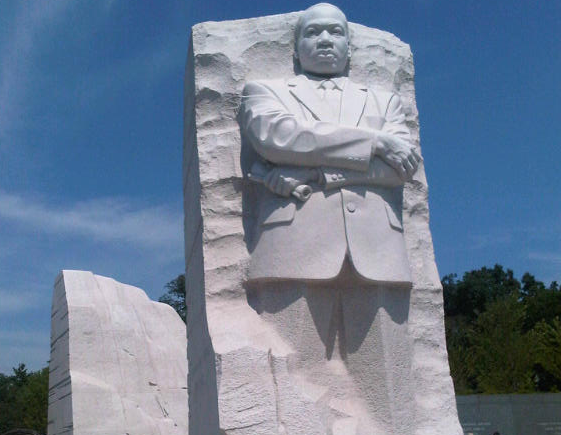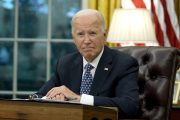
Their complaints are many; one of the main concerns of even leftist blacks is that a Chinese communist sculptor, who adores communist mass-murderer Mao Zedong, created the effigy of King.
The Statue
President Bill Clinton signed into law the legislation authorizing the King Memorial. The $120 million memorial has been 15 years in the making. It sits on four acres on the National Mall between the Jefferson and Lincoln memorials and features a 30-foot tall King. The head alone weighs 46 tons, and some of the blocks of granite used to construct the behemoth weigh 55 tons
The statue is larger than Jefferson’s and Lincoln’s, which stand at about 19 feet a piece. Its main features are a "Stone of Hope," a “Mountain of Despair,” and an inscription wall
 Hilariously, the King family charged the foundation that built this monument $800,000 to use the excerpts from King’s speeches and writings in its fundraising effort. The family jealously guards King’s image and written material, an irony given that King stole much of what he wrote from others, including substantial sections of his doctoral dissertation for Boston University. When the King plagiarism was discovered and documented in full, his supporters excused it as a “tradition” among Southern black preachers, and Boston University refused to revoke the academic thief’s doctorate.
Hilariously, the King family charged the foundation that built this monument $800,000 to use the excerpts from King’s speeches and writings in its fundraising effort. The family jealously guards King’s image and written material, an irony given that King stole much of what he wrote from others, including substantial sections of his doctoral dissertation for Boston University. When the King plagiarism was discovered and documented in full, his supporters excused it as a “tradition” among Southern black preachers, and Boston University refused to revoke the academic thief’s doctorate.
Complaints
But the size of the memorial and its cost, $120 million, aren’t the problems. Critics complain that the statue doesn’t fully resemble Martin Luther King and wrongly depicts him as angry and ready to lash out in fury. They also complain that the statue was carved by Lei Yixin, a Red sculptor and defender of Mao Zedong who has also carved statues of the communist mass murderer.
Courtland Milloy, a columnist for the Washington Post, summed up the complaints a week or so ago. “Surely, having a black sculptor of a black civil rights icon — working on ground once toiled by black slaves, on the National Mall, designed and surveyed with the help of a black mathematician and astronomer Benjamin Banneker — would have added to the King memorial’s symbolic power,” he wrote.
So, yes, it stings when, centuries later, creators of the King memorial say they couldn’t find a qualified black sculptor….
Who gets the job? A Chinese national with an apparent preference for the heroic and authoritarian.
The sculpture is based on a 1966 photograph of King taken in his office in Atlanta, standing at his desk, with a picture of Indian leader Mohandas Gandhi on a wall in the background. In it, King has soft eyes and an open face that conveys the blessed assurance of a man who walks by faith.
Lei Yixin has turned those eyes into something of a steely squint.
The result is a stern colossus, dressed no less in a style of suit similar to ones found on many statues of Stalin. In America’s militaristic culture, King’s take-no-prisoners personae will surely resonate — especially among many in the black middle class, which places a premium on order and discipline. King’s expression reminds me of a parent or teacher about to administer some tough love with a belt.
As for resemblance, that King appears Asian is obvious. As the NorCal blog’s Gate observed, “The sculpture of MLK looks eerily like a black Chinese Dictator. It's as if the artist used the body from some old Chairman Mao statue and stuck an oriental looking Martin Luther King head on it. Seriously, check out his eyes and forehead. It’s as if the artist used Photoshop to lift MLK’s face off a picture and pasted it to a bust of Mao.”
The blog features photos of King, the head of King’s statue and a bust of Mao.
Gilbert Young, a black artist, started the “King is Ours” online petition that said a Chinese sculptor was not the right choice for the memorial. “The planned monument to our beloved Dr. Martin Luther King, Jr. has been awarded to an artist from a country with a reprehensible history of civil rights violations against its people.”
The granite to be used for King’s sculpture will be harvested using slave labor — Chinese workers are not even provided masks to protect their lungs from the silica dust. They die in droves because the Chinese government considers them just as important as the students who protested in Tiananmen Square. The world watched the tanks roll over them. No human rights, No civil rights, and yet the honor of sculpting Dr. Martin Luther King? Not on our watch.
Young’s petition also noted that no one would consider permitting an artist famous for his statues of Adolf Hitler to fashion a likeness of Anne Frank.
Maya Angelou, the black poetess, said the inscription on the block of granite from which King emerges, arms folded, to stare down at the visitors, makes King appear to be an “arrogant twit.” The inscription reads: “I was a drum major for peace, justice and righteousness.” Problem is, says Angelou, the words only paraphrase what King said in a sermon he gave at Ebeneezer Baptist Church in Atlanta, Georgia, on February 4, 1968, wherein King pondered what encomiums he might receive.
“If you want to say that I was a drum major, say that I was a drum major for justice,” King said. “Say that I was a drum major for peace. I was a drum major for righteousness. And all of the other shallow things will not matter.”
“The quote makes Dr. Martin Luther King look like an arrogant twit,” the 83-year-old Angelou told the Washington Post, which described her unhappiness at length:
“He was anything but that. He was far too profound a man for that four-letter word to apply.
“He had no arrogance at all,” she said. “He had a humility that comes from deep inside.
“The ‘if’ clause that is left out is salient. Leaving it out changes the meaning completely.”
The paraphrase “minimizes the man,” she said. “It makes him seem less than the humanitarian he was…. It makes him seem an egotist.”
But what was the real man really like? And how should we remember him? According to Julian Bond, who knew King personally, and who served as chairman of the NAACP decades later, from 1998-2010, the Dr. Martin Luther King we celebrate today has been "anesthetized." In a January 2010 interview with The Young Turks, Bond said: "We don't remember the King who was the critic of capitalism who said … that he thought a modified form of socialism would be the best system for the United States…. So we've anesthetized him. We've made him into a different kind of person than he actually was in real life. And it may be that that's one reason he is so celebrated today because we celebrate a different kind of man than really existed."
Photo of King monument: AP Images
Related article:




